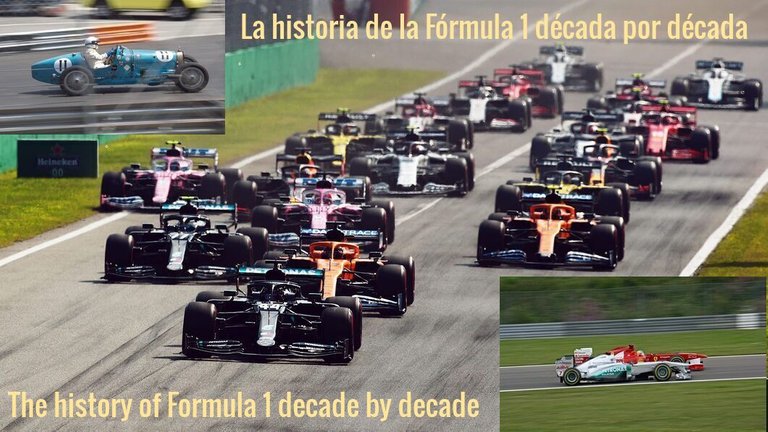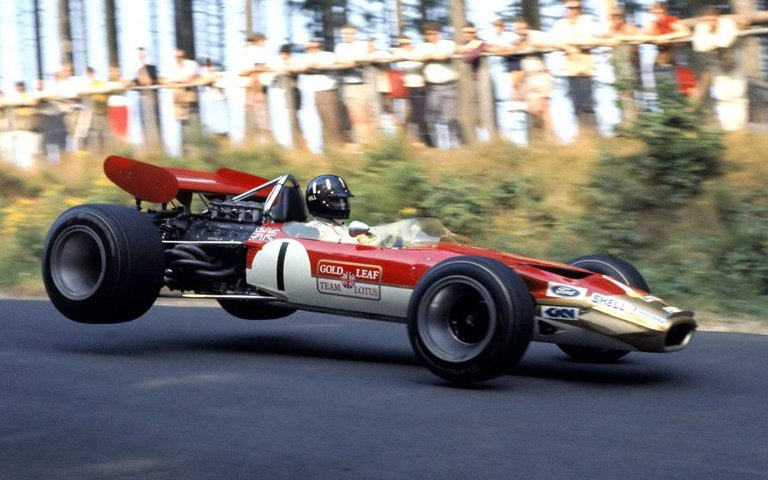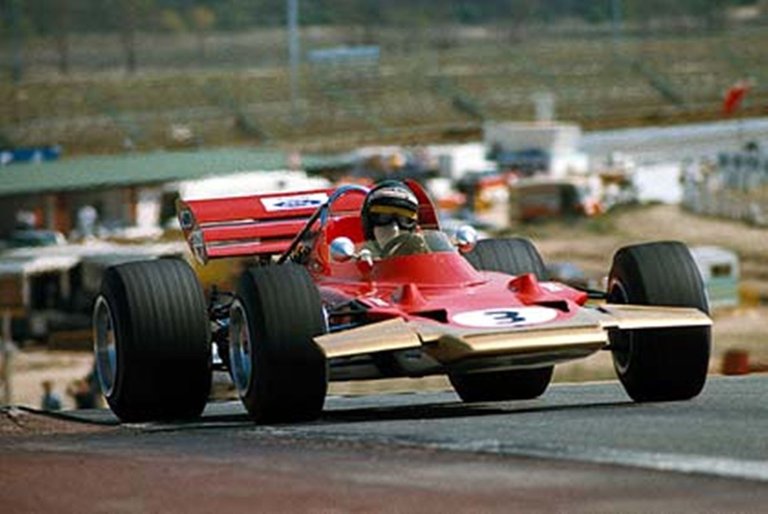[ESP/ENG] Fórmula 1 tres cuartos de siglo repartiendo emociones, títulos y grandes campeones, segunda década (1961-1970) / Formula 1 three quarters of a century sharing emotions, titles and great champions, second decade (1961-1970).

Les sigo hablando de los orígenes de la Fórmula 1 anticipando lo que será el año próximo el festejo por el 75° Aniversario en la máxima categoría del automovilismo deportivo.
En el primer post (sobre un total de siete) recordando década a década los sucesos más importantes les había hablado sobre los sucesos italianos ya sea a nivel de pilotos que de marcas, con el quíntuple campeonato obtenido por Juan Manuel Fangio que le permite -aún hoy- estar en la elite, en el podio, de los pilotos con mayor número de títulos obtenidos.
Solo Michael Schumacher y Lewis Hamilton hicieron mejor que él. El "Chueco" de Balcarce (Argentina) fue el verdadero ídolo generacional en una década en la que tuvo que luchr con figuras ya consagradas como Nino Farina y Alberto Ascari entre otros.
Dejamos la primera década (1950-1960) y nos adentramos a ver que sucedía en la segunda década (1961-1970)

I continue talking about the origins of Formula 1 in anticipation of what will be next year's celebration of the 75th anniversary of the highest category of motorsport.
In the first post (out of a total of seven) recalling decade by decade the most important events I had told you [about the Italian events both at driver and brand level](https://hive. blog/hive-189157/@greengalletti/espeng-formula-1-three-quarters-of-a-century-reparing-emotions-titles-and-great-champions-formula-1-three-quarters-of-a-century-), with the quintuple championship won by Juan Manuel Fangio that allows him - still today - to be in the elite, on the podium, of the drivers with the highest number of titles won.
Only Michael Schumacher and Lewis Hamilton did better than him. The "Chueco" from Balcarce (Argentina) was the true generational idol in a decade in which he had to fight with already established figures such as Nino Farina and Alberto Ascari, among others.
We leave the first decade (1950-1960) and we go into the second decade (1961-1970).
La segunda década (1961-1970) fue también llamada la "década de oro británica". / The second decade (1961-1970) was also called the "British golden decade".

Así como la primera década fue patrimonio (casi) exclsuive de pilotos y marcas italianas, la segunda década, en cambio, vio favoritos a los británicos.
Al inicio de la Fórmula 1 los italianos tenían motores desarrollados con muchos años de anticipación y pudieron, de esta manera, aventajarse sobre sus rivales que comenzaban a hacer sus primeros pasos.
Para tener una idea de esta circunstancia es suficiente un dato: cuando Nino Farina gana en el año 1950 con un Alfa Romeo 158 ese auto en realidad tenía ya trece años de desarrollado en las fábricas italianas.
La segunda década, con algunos cambios y motores más potenciados, iba a comenzar sin embargo con un hecho trágico que es considerado el más grave en la historia de la nueva categoría. En 1961 el piloto alemán Wolfgang Von Trips joven promesa del automovilismo y para muchos críticos de la época futuro campeón, pierde la vida junto a quince espectadores en un accidente en Autódromo de Monza mientras se disputaba el Gran Premio de Italia y era asediado a sus espaldas por Jim Clark. Chocan entre ambos y el auto de Von Trips sale lieralmente despedido contra las redes de contención, subidos a las cuáles numerosos espectacdores presenciaban la carrera.
Está considerado, aún hoy, el más grave accidente en la Fórmula 1.
Los triunfos británicos que había inaugurado en 1958 Mike Hawthorn se iban a consolidar en seis oportunidades más de la mano de Graham Hill (1962 y 1968), Jim Clark con otro doblete en los años 1963 y 1965, mientras cierran esta impresionante serie de sucesos británicos John Surtess en el año 1964 que después crearía su propio equipo al igual que Jack Stewart el "escocés volador" en 1969.
Solo los australianos pudieron oponerse a este dominio absoluto. Jack Brabham que había ganado en 1960 en 1966 y en 1967 su connacional Dennis Hulme vuelve a hacer flamear la bandera australiano en lo más alto del podio ganando el título mundial de pilots en el año 1967.
Jochen Rindt, austríaco, cierra esta década en modo glorioso y trágico a la vez. Cuando ya había acumulado los puntos suficientes para coronarse campeón mundial encuentra la muerte en un accidente en las pruebas de clasificación en el Autódromo de Monza (Italia), de nuevo triste escenario en la desaparición de un piloto.
Junto con Graham Hill, un par de años antes, comenzaba a reportar el equipo Lotus a los primeros planos de la Fórmula 1.

Just as the first decade was the (almost) exclusive patrimony of Italian drivers and brands, the second decade, on the other hand, saw the British as favorites.
At the beginning of Formula 1, the Italians had engines developed many years in advance and were thus able to gain an advantage over their rivals who were just starting to take their first steps.
To have an idea of this circumstance, just one fact is enough: when Nino Farina won in 1950 with an Alfa Romeo 158, that car had already been developed in the Italian factories for thirteen years.
The second decade, with some changes and more powerful engines, was to begin, however, with a tragic event that is considered the most serious in the history of the new category. In 1961, the German driver Wolfgang Von Trips, a promising young motor racing driver and for many critics of the time a future champion, lost his life along with fifteen spectators in an accident at the Monza racetrack while the Italian Grand Prix was being held and he was besieged behind him by Jim Clark. They collided and Von Trips' car was thrown into the crash barrier nets, on which numerous spectators were watching the race.
It is still considered, even today, the most serious accident in Formula 1.
The British triumphs inaugurated in 1958 by Mike Hawthorn were to be consolidated six more times by Graham Hill (1962 and 1968), Jim Clark with another double in 1963 and 1965, while John Surtess closed this impressive series of British events in 1964, who would later create his own team, as well as Jack Stewart, the "Flying Scotsman" in 1969.
Only the Australians were able to oppose this absolute domination. Jack Brabham, who had won in 1960, in 1966 and in 1967 his compatriot Dennis Hulme made the Australian flag fly again at the top of the podium, winning the world drivers' title in 1967.
Jochen Rindt, Austrian, closes this decade in a glorious and tragic way at the same time. When he had already accumulated enough points to be crowned world champion, he died in an accident in the qualifying tests at the Monza racetrack (Italy), another sad scene in the demise of a driver.
Together with Graham Hill, a couple of years earlier, he began to bring the Lotus team to the forefront of Formula 1.
Los primeros cambios. / The first changes.

En 1961, al inicio de la segunda década, la Fórmula 1 decide comenzar a pensar en forma concreta sobre la seguridad en las pistas considerando los accidentes mortales ocurridos en una pista rápida como la de Monza, con un largo rectilíneo, y para ello actúa la primera medida de importancia en la categoría: limita la velocidad. Y lo hace restringiendo los motores a 1,5 litros no supercargados medida que fue adelante por cinco años.
Ferrari decide ir más adelante diseñando un sofisticado auto impulsado por un motor V6 a 120º con el cuál gana el campeonato de 1961 con la conducción del estadounidense Phil Hill. Pero los elevados costos del proyecto obligan a abandonarlo y volver sobre los pasos del proyecto anterior.
Con un un chasis construido en lámina de aluminio monocasco inicia la era de Lotus y Jim Clark.
El tema de los motores comienza aser crucial y John Surtess campeón del mundo en 1964 (único piloto hasta hoy que fue campeón en F1 y en motos) utilizó no menos de 3 motores diferentes en esta temporada, comenzando por un V6, sgiuiendo después por un un V8 para terminar con uno de 12 cilindros en línea.
Las roturas en los motores (hoy en día muy raros) con el clásico humo blanco que salía de los escapes y bañaba la pista de aceite comenzó a hacerse sentir cada vez más con mayor frecuencia.
Hacia el final de la segunda década hace su entrada en escena la empresa aeronáutica francesa Matra que produce los motores Cosworth y que por primera vez alimentaron los motoresde los autos del equipo de Ken Tyrrell.

In 1961, at the beginning of the second decade, Formula 1 decided to start thinking concretely about safety on the tracks, considering the fatal accidents that occurred on a fast track like Monza, with a long straight line, and for this reason it adopted the first important measure in the category: it limited the speed. And it does so by restricting the engines to 1.5 liters not supercharged, a measure that went ahead for five years.
Ferrari decides to go further by designing a sophisticated car powered by a 120º V6 engine with which it wins the 1961 championship with the American driver Phil Hill. But the high costs of the project forced to abandon it and retrace the steps of the previous project.
With a chassis built in aluminum sheet monocoque, the era of Lotus and Jim Clark begins.
The engine issue becomes crucial and John Surtess, world champion in 1964 (the only driver until today who was champion in F1 and motorcycles) used no less than 3 different engines in this season, starting with a V6, followed by a V8 and ending with an in-line 12-cylinder engine.
Engine breaks (nowadays very rare) with the classic white smoke coming out of the exhausts and bathing the track in oil began to be felt more and more frequently.
Towards the end of the second decade, the French aeronautical company Matra entered the scene, producing Cosworth engines, which for the first time powered the engines of Ken Tyrrell's team cars.
El business de la esponsorizacion / The sponsoring business.

El auge del automovilismo deportivo en esta segunda década lleva a la FIA y a los equipos a pensar en una innovación de carácter económico para apoyar el desarrollo de nuevos motores, chasis y mejorar los autos en general.
Nacen así los esponsores en la Fórmula 1, hoy moneda corriente e insustituible.
El primero en adoptarlos fue Lotus. Hasta ese momento el color de los autos estaba ligado a la nacionalidad de cada piloto. En 1968 Lotus debuta con nuevos colores: el rojo, el dorado y el balnco que luego serín substituídos por el negro y el dorado que representaban a la tabacalera Gold Leaf.
Fue el inicio de las grandes compañas tabacaleras apoyando la Fórmula 1 durnte varias décadas hasta que en el año 2006 La Federación Internacional del Automóvil, prohibió toda publicidad de tabaco en los autos de la Fórmula 1.

The rise of motorsport in this second decade led the FIA and the teams to think of an economic innovation to support the development of new engines, chassis and to improve the cars in general.
This is how sponsors were born in Formula 1, nowadays a common and irreplaceable currency.
The first to adopt them was Lotus. Until then, the color of the cars was linked to the nationality of each driver. In 1968 Lotus debuted with new colors: red, gold and white, which were later replaced by black and gold, representing the Gold Leaf tobacco company.
It was the beginning of the great tobacco companies supporting Formula 1 for several decades until 2006, when the International Automobile Federation banned all tobacco advertising on Formula 1 cars.

1; 2; 3.-
El separador de párrafos -modificado por el autor- es propiedad del usuario @thepeakstudio. A él mi agradecimiento por el excelente material gráfico puesto a disposición de la Comunidad.
The paragraph separator -modified by the author- is property of the user @thepeakstudio. To him my thanks for the excellent graphic material made available to the Community.
El banner titulado Reseñas Deportivas / Sports Reviews personalizado por el autor es propiedad de PNGWing.
The banner titled Reseñas Deportivas / Sports Reviews customized by the author is property of PNGWing.
